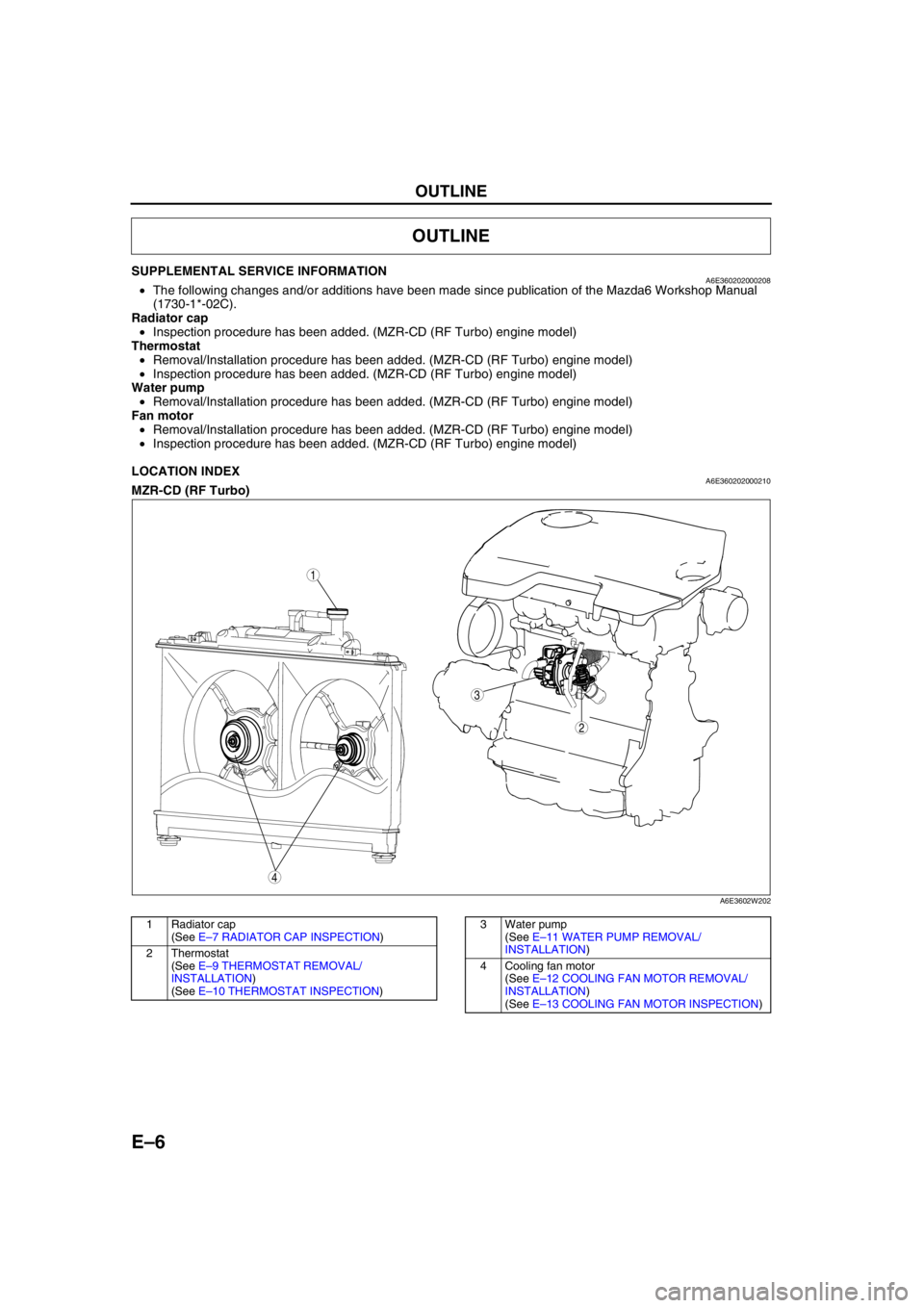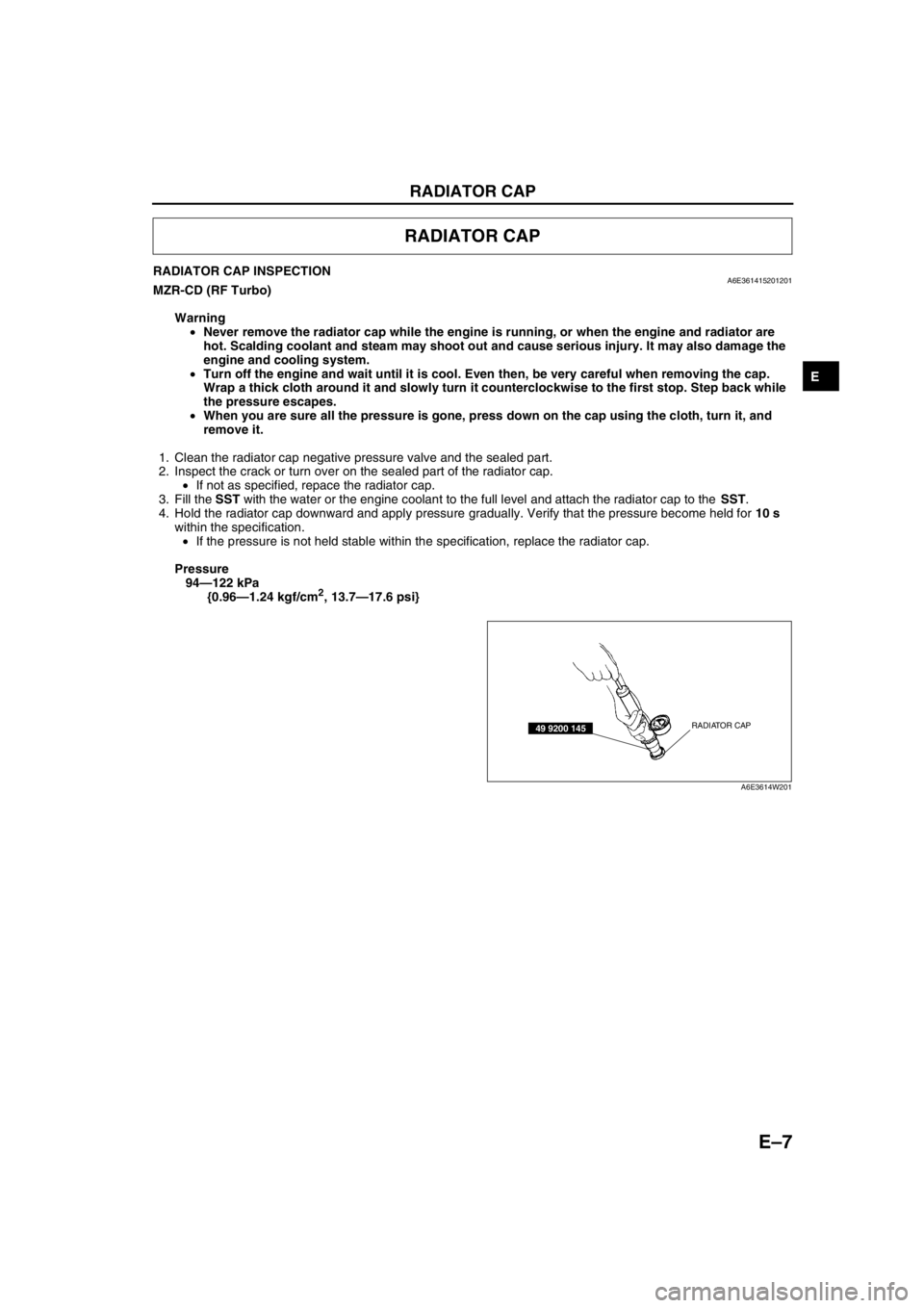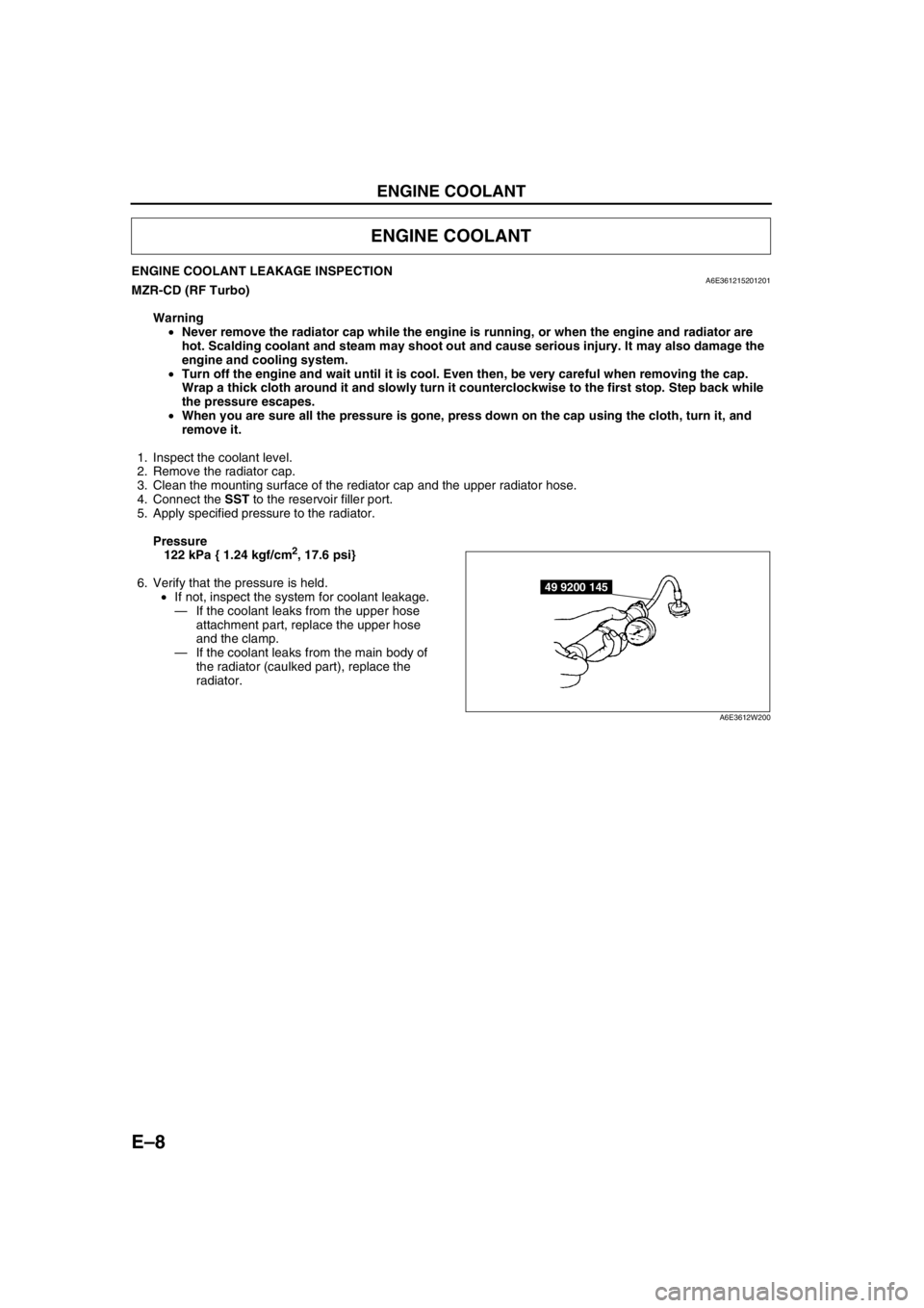MAZDA 6 2002 Suplement Manual Online
Manufacturer: MAZDA, Model Year: 2002, Model line: 6, Model: MAZDA 6 2002Pages: 909, PDF Size: 17.16 MB
Page 81 of 909

E–6
OUTLINE
SUPPLEMENTAL SERVICE INFORMATIONA6E360202000208•The following changes and/or additions have been made since publication of the Mazda6 Workshop Manual
(1730-1*-02C).
Radiator cap
•Inspection procedure has been added. (MZR-CD (RF Turbo) engine model)
Thermostat
•Removal/Installation procedure has been added. (MZR-CD (RF Turbo) engine model)
•Inspection procedure has been added. (MZR-CD (RF Turbo) engine model)
Water pump
•Removal/Installation procedure has been added. (MZR-CD (RF Turbo) engine model)
Fan motor
•Removal/Installation procedure has been added. (MZR-CD (RF Turbo) engine model)
•Inspection procedure has been added. (MZR-CD (RF Turbo) engine model)
End Of Sie
LOCATION INDEXA6E360202000210MZR-CD (RF Turbo)
.
End Of Sie
OUTLINE
4
3
1
2
A6E3602W202
1 Radiator cap
(See E–7 RADIATOR CAP INSPECTION)
2Thermostat
(See E–9 THERMOSTAT REMOVAL/
INSTALLATION)
(See E–10 THERMOSTAT INSPECTION)3 Water pump
(See E–11 WATER PUMP REMOVAL/
INSTALLATION)
4 Cooling fan motor
(See E–12 COOLING FAN MOTOR REMOVAL/
INSTALLATION)
(See E–13 COOLING FAN MOTOR INSPECTION)
Page 82 of 909

RADIATOR CAP
E–7
E
RADIATOR CAP INSPECTIONA6E361415201201MZR-CD (RF Turbo)
Warning
•Never remove the radiator cap while the engine is running, or when the engine and radiator are
hot. Scalding coolant and steam may shoot out and cause serious injury. It may also damage the
engine and cooling system.
•Turn off the engine and wait until it is cool. Even then, be very careful when removing the cap.
Wrap a thick cloth around it and slowly turn it counterclockwise to the first stop. Step back while
the pressure escapes.
•When you are sure all the pressure is gone, press down on the cap using the cloth, turn it, and
remove it.
1. Clean the radiator cap negative pressure valve and the sealed part.
2. Inspect the crack or turn over on the sealed part of the radiator cap.
•If not as specified, repace the radiator cap.
3. Fill the SST with the water or the engine coolant to the full level and attach the radiator cap to the SST.
4. Hold the radiator cap downward and apply pressure gradually. Verify that the pressure become held for 10 s
within the specification.
•If the pressure is not held stable within the specification, replace the radiator cap.
Pressure
94—122 kPa
{0.96—1.24 kgf/cm
2, 13.7—17.6 psi}
End Of Sie
RADIATOR CAP
RADIATOR CAP49 9200 145
A6E3614W201
Page 83 of 909

E–8
ENGINE COOLANT
ENGINE COOLANT LEAKAGE INSPECTIONA6E361215201201MZR-CD (RF Turbo)
Warning
•Never remove the radiator cap while the engine is running, or when the engine and radiator are
hot. Scalding coolant and steam may shoot out and cause serious injury. It may also damage the
engine and cooling system.
•Turn off the engine and wait until it is cool. Even then, be very careful when removing the cap.
Wrap a thick cloth around it and slowly turn it counterclockwise to the first stop. Step back while
the pressure escapes.
•When you are sure all the pressure is gone, press down on the cap using the cloth, turn it, and
remove it.
1. Inspect the coolant level.
2. Remove the radiator cap.
3. Clean the mounting surface of the rediator cap and the upper radiator hose.
4. Connect the SST to the reservoir filler port.
5. Apply specified pressure to the radiator.
Pressure
122 kPa { 1.24 kgf/cm
2, 17.6 psi}
6. Verify that the pressure is held.
•If not, inspect the system for coolant leakage.
—If the coolant leaks from the upper hose
attachment part, replace the upper hose
and the clamp.
—If the coolant leaks from the main body of
the radiator (caulked part), replace the
radiator.
End Of Sie
ENGINE COOLANT
49 9200 145
A6E3612W200
Page 84 of 909

THERMOSTAT
E–9
E
THERMOSTAT REMOVAL/INSTALLATIONA6E361815171201MZR-CD (RF Turbo)
1. Disconnect the negative battery cable.
2. Remove the under cover.
3. Drain the engine coolant.
4. Remove in the order indicated in the table.
5. Install in the reverse order of removal.
6. Fill the radiator with the specified amount and type of engine coolant.
7. Inspect the engine coolant leakage. (See E–8 ENGINE COOLANT LEAKAGE INSPECTION.)
Thermostat Installation Note
1. Verify that the positions of the jiggle pin and the projection on the gasket are as shown.
2. Install the thermostat into the thermostat case, aligning the projection on the gasket to the thermostat cover.
End Of Sie
THERMOSTAT
1 Lower radiator hose
2 Thermostat cover
3Thermostat
(See E–9 Thermostat Installation Note )
3
1
2
7.9—10.7 N·m
{80—110 kgf·cm,
69.5—95.4 in·lbf}
A6E3618W100
THERMOSTAT
COVER
GASKET
PROJECTIONJIGGLE PIN
A6A3618W101
Page 85 of 909

E–10
THERMOSTAT
THERMOSTAT INSPECTIONA6E361815171202MZR-CD (RF Turbo)
1. Inspect the thermostat for the following.
•Closed valve at room temperature
•Opening temperature and lift of the valve
—If not as specified, replace the thermostat.
End Of Sie
Condition Specification
Initial-opening temperature
80—84 {176—183}
(°C {°F})
Full-open temperature
95 {203}
(°C {°F})
Full-open lift (mm {in}) More than 8.5 {0.33}
A6E3618W102
Page 86 of 909

WATER PUMP
E–11
E
WATER PUMP REMOVAL/INSTALLATIONA6E362015010201MZR-CD (RF Turbo)
1. Disconnect the negative battery cable.
2. Remove the under cover.
3. Drain the engine coolant.
4. Remove the timing belt. (See B2–9 TIMING BELT REMOVAL/INSTALLATION.)
5. Remove the thermostat. (See E–9 THERMOSTAT REMOVAL/INSTALLATION.)
6. Remove in the order indicated in the table.
7. Install in the reverse order of removal.
8. Insect the drive belt. (See B2–4 DRIVE BELT INSPECTION.)
9. Fill the radiator with the specified amount and type of engine coolant.
10. Inspect the engine coolant leakage. (See E–8 ENGINE COOLANT LEAKAGE INSPECTION.)
End Of Sie
WATER PUMP
3
1
2
1
19—25
{1.9—2.6, 14—18}
N·m {kgf·m, ft·lbf} 38—51
{3.8—5.3, 28—38}
7.9—10.7 N·m
{80—110 kgf·cm, 69.5—95.4 in·lbf} 38—51
{3.8—5.3, 28—38}
R
R
A6E3620W100
1Hose
2 Water pump
3 Thermostat case
Page 87 of 909

E–12
FAN MOTOR
COOLING FAN MOTOR REMOVAL/INSTALLATIONA6E362215025201MZR-CD (RF Turbo)
1. Remove the cooling fan component.
2. Remove in the order indicated in the table.
3. Install in the reverse order of removal.
4.
End Of Sie
FAN MOTOR
4
3
1
2
2.9—3.9 N·m
{29.5—39.8 kgf·cm,
25.6—33.9 in·lbf}
3.9—4.9 N·m
{39.7—50.0 kgf·cm,
34.7—43.4 in·lbf}
3.9—4.9 N·m
{39.7—50.0 kgf·cm,
34.7—43.4 in·lbf}
A6E3621W101
1 Cooling fan No.2
2 Cooling fan No.1
3 Cooling fan motor No.2
4 Cooling fan motor No.1
Page 88 of 909

FAN MOTOR
E–13
E
COOLING FAN MOTOR INSPECTIONA6E362215025202MZR-CD (RF Turbo)
1. Verify that the battery is fully charged.
•Charge if necessary. (See G–6 BATTERY RECHARGING.)
2. Connect battery positive voltage and an ammeter to the cooling fan motor connector.
3. Verify that the cooling fan motor operates smoothly at the standard current draw.
•If not as specified, replace the cooling fan motor.
End Of Sie
Item Current (A) [12V]
Cooling fan motor No.1 4.4—7.4
Cooling fan motor No.2 6.3—9.3
AB
A B
TERMINAL No.
COOLING FAN MOTOR
CONNECTOR
A6E3621W102
Page 89 of 909
![MAZDA 6 2002 Suplement Manual Online F1–1
F1
F1FUEL AND EMISSION CONTROL SYSTEM
[L8, LF, L3]
OUTLINE.............................................................. F1-2
OUTLINE OF CONSTRUCTION ....................... F1-2
FEATURES ..... MAZDA 6 2002 Suplement Manual Online F1–1
F1
F1FUEL AND EMISSION CONTROL SYSTEM
[L8, LF, L3]
OUTLINE.............................................................. F1-2
OUTLINE OF CONSTRUCTION ....................... F1-2
FEATURES .....](/img/28/57057/w960_57057-88.png)
F1–1
F1
F1FUEL AND EMISSION CONTROL SYSTEM
[L8, LF, L3]
OUTLINE.............................................................. F1-2
OUTLINE OF CONSTRUCTION ....................... F1-2
FEATURES ........................................................ F1-2
SPECIFICATIONS ............................................. F1-2
CONTROL SYSTEM DIAGRAM (4WD)............. F1-3
CONTROL SYSTEM WIRING DIAGRAM
(4WD).............................................................. F1-4
FUEL SYSTEM..................................................... F1-9
OUTLINE ........................................................... F1-9
STRUCTURAL VIEW......................................... F1-9
SYSTEM DIAGRAM ........................................ F1-10
FUEL PUMP (TRANSFER).............................. F1-10
QUICK RELEASE CONNECTOR (FUEL TANK
SIDE, TRANSFER HOSE PART) ................. F1-12
EXHAUST SYSTEM........................................... F1-13
OUTLINE ......................................................... F1-13
STRUCTURAL VIEW....................................... F1-13
CONTROL SYSTEM........................................... F1-14
OUTLINE ......................................................... F1-14
STRUCTURAL VIEW (4WD) ........................... F1-16
BLOCK DIAGRAM ........................................... F1-17
CONTROL DEVICE AND CONTROL
RELATIONSHIP CHART .............................. F1-19
CONTROLLER AREA NETWORK (CAN) ....... F1-21
OUTLINE............................................................ F1-22
SUPPLEMENTAL SERVICE
INFORMATION ............................................. F1-22
ENGINE TUNE-UP............................................. F1-22
IDLE SPEED INSPECTION (4WD) ................. F1-22
FUEL SYSTEM................................................... F1-23
FUEL TANK REMOVAL/INSTALLATION ........ F1-23
FUEL PUMP UNIT
REMOVAL/INSTALLATION .......................... F1-26
FUEL HOSE (FUEL TANK SIDE,
TRANSFER HOSE PART)
REMOVAL/INSTALLATION .......................... F1-29
EXHAUST SYSTEM........................................... F1-30
EXHAUST SYSTEM
REMOVAL/INSTALLATION .......................... F1-30
CONTROL SYSTEM........................................... F1-33
PCM INSPECTION (4WD)............................... F1-33
ON-BOARD DIAGNOSTIC................................. F1-50
OUTLINE ......................................................... F1-50
CONTROL DEVICE AND MONITORING
SYSTEM RELATIONSHIP CHART .............. F1-50
DIAGNOSTIC TEST MODE (4WD) ................. F1-50
DTC (4WD) ...................................................... F1-52
OBD DRIVE MODE ......................................... F1-52
DTC TABLE ..................................................... F1-54
TROUBLESHOOTING........................................ F1-57ENGINE SYMPTOM
TROUBLESHOOTING .................................. F1-57
QUICK DIAGNOSTIC CHART ......................... F1-58
NO.14 POOR FUEL ECONOMY ..................... F1-62
NO.22 VIBRATION CONCERNS
(ENGINE) ...................................................... F1-64 FEATURES
SERVICE
Page 90 of 909

F1–2
OUTLINE
OUTLINE OF CONSTRUCTIONA6E390218881201•The fuel and emission control systems are essentially carried over from the current Mazda6 (GG), except for
the following features. (See Mazda6 Training Manual 3359-1*-02C.)
End Of Sie
FEATURESA6E390218881202System simplification
•Controller area network has been adopted with TCM communication (4WD).
TCM adoption
•DTC for CAN (TCM communication) has been adopted.
Modifications to match the vehicle characteristics
•The idle speed has been modified.
•Fuel pump (transfer) has been adopted.
End Of Sie
SPECIFICATIONSA6E390218881203
*1: Without the BARO sensor
*2: With the BARO sensor
Bold frames: New specifications
End Of Sie
OUTLINE
Item 2WD 4WD
Air cleaner element Type Paper element (oil permeated)
IAC valve Type Duty control
Fuel injectorType Hi-ohmic
Type of fuel delivery Top-feed
Type of drive Voltage
Pressure regulatorRegulating pressure
(kPa {kgf/cm
2, psi})440 {4.5, 64}
Fuel tankCapacity
(L {US qt, lmp qt})64 {68, 56} 62 {65, 54}
Fuel SpecificationUnleaded
(RON 90*
1/95*2 or above)Unleaded (RON 95 or above)
Catalyst Type TWC (monolythic)
EGR control Type Stepping motor type
Evaporative emission control
systemType Canister type
PCV system Type Closed type